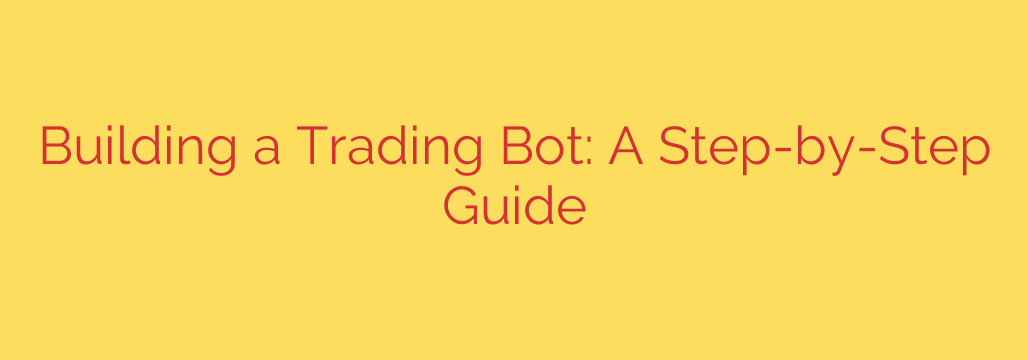
How to Build a Trading Bot From Scratch: A Comprehensive Guide
Automated trading has transformed the financial landscape, offering a way to execute strategies with precision and speed that manual trading simply cannot match. By leveraging a trading bot, you can remove emotion from your decisions, operate 24/7, and capitalize on market opportunities in milliseconds. But how do you go from a trading idea to a fully functional automated system?
This guide will walk you through the essential steps to build your own trading bot, from conceptualizing a strategy to deploying it securely.
1. The Cornerstone: Develop a Solid Trading Strategy
Before writing a single line of code, you need a clear, objective, and testable trading strategy. A bot is only as good as the logic it executes. Your strategy is the set of rules that will dictate every buy and sell decision.
Start by defining the core components:
- Market Selection: Will you be trading cryptocurrencies, stocks, forex, or commodities? The market you choose will influence the data you need and the exchange API you use.
- Entry Signals: What specific conditions must be met for the bot to open a position? This could be based on technical indicators like a Moving Average Crossover, RSI levels, or a specific chart pattern.
- Exit Signals: Just as important, when will the bot close a position? This includes both taking profit at a predetermined target and cutting losses with a stop-loss order to manage risk.
- Position Sizing: How much capital will the bot risk on a single trade? A common rule is to risk only 1-2% of your total trading capital per position.
Your strategy must be 100% rule-based. There can be no room for ambiguity. If you can’t write it down as a simple “if-then” statement, your bot won’t be able to execute it.
2. Choose Your Technology Stack
With a strategy in hand, it’s time to select the tools for the job. For most developers, the choice is clear.
- Programming Language: Python is the undisputed leader in the algorithmic trading space. Its simple syntax, extensive community support, and powerful data science libraries make it the ideal choice.
- Essential Libraries: You don’t need to build everything from scratch. Leverage open-source libraries to speed up development:
- Pandas: For manipulating and analyzing time-series data (like price history).
- TA-Lib or Pandas TA: For calculating hundreds of technical indicators.
- CCXT: A universal library that connects to over 100 cryptocurrency exchanges, standardizing the process of fetching data and placing orders.
- Exchange Platform: Select a reputable exchange that offers a robust and well-documented API (Application Programming Interface). Check their API rate limits, fees, and security features before committing.
3. Connect to the Market with an API
The API is the bridge between your code and the exchange. It allows your bot to programmatically access market data and execute trades without you needing to log in to the platform manually.
When you generate API keys from your exchange, you will receive a public key (for identification) and a secret key (for authentication). Protecting these keys is paramount to your account’s security.
Actionable Security Tips:
- Never hardcode your API keys directly into your script. Store them as environment variables or in a secure configuration file that is excluded from version control (like Git).
- Restrict API permissions. When creating your keys, only enable the permissions your bot absolutely needs. For example, if your bot only needs to trade, disable withdrawal permissions on the API key.
- Use IP whitelisting if your exchange offers it. This ensures that API requests can only come from a trusted IP address, like your server.
4. Backtest Your Strategy Rigorously
Backtesting is the process of simulating your trading strategy on historical market data to see how it would have performed in the past. This is a critical, non-negotiable step to validate your logic before risking real money.
A proper backtest will give you insights into key performance metrics like:
- Total Profit/Loss
- Win Rate
- Maximum Drawdown (the largest peak-to-trough decline)
- Profit Factor
During this phase, beware of a common pitfall known as overfitting. This occurs when you tweak your strategy’s parameters to perfectly fit the historical data. While it may look incredible in the backtest, an overfitted strategy often fails in live market conditions because it’s tailored to past noise rather than a robust market pattern.
5. Code the Logic and Deploy Your Bot
Now you can bring everything together. The core of your bot will be a main loop that continuously:
- Fetches the latest market data via the API.
- Calculates indicators based on your strategy.
- Checks if your entry or exit conditions have been met.
- Executes buy or sell orders if a signal is triggered.
- Logs every action for later review.
Once your bot is coded and tested, you can’t just run it on your laptop, which can lose internet connection or shut down. For 24/7 operation, you need to deploy it to a server. A Virtual Private Server (VPS) is a cost-effective and reliable solution for hosting a trading bot.
6. Monitor Performance and Manage Risk
Launching your bot is not the end of the journey. A trading bot is not a “set-it-and-forget-it” money printer. You must actively monitor its performance, review its trade logs, and ensure it is behaving as expected.
Markets change, and a strategy that worked last year may not work next year. Be prepared to refine your logic or even turn the bot off if it consistently underperforms. Always remember that automated systems can fail, whether due to a bug, an API outage, or extreme market volatility. Continuous oversight and a solid risk management framework are your best defenses against significant losses.
Source: https://kifarunix.com/how-to-construct-a-trading-bot-your-step-by-step-guide-to-automation/








